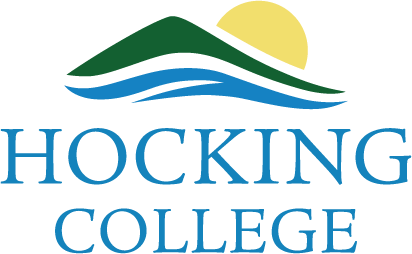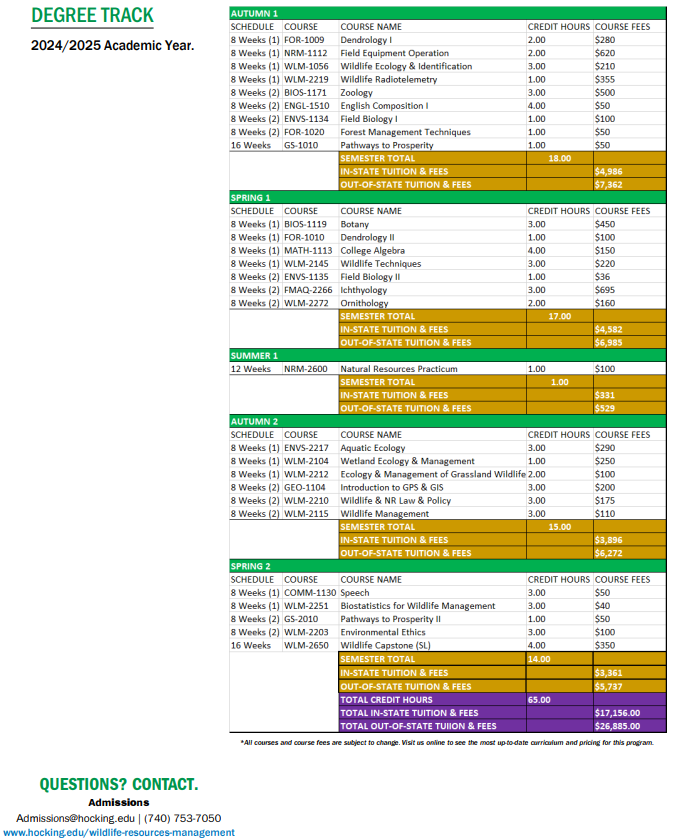Wildlife Resources Management Program Description
The Wildlife program at Hocking College is a hands-on, experience-based curriculum. Students actively learn and practice field skills here that they will only hear about in other more traditional wildlife management programs.
In addition, students leave our program with a strong conceptual understanding of wildlife management, ecology, and conservation, as well as botany and plant ecology and identification, and natural resources as a whole.
Skills learned include wildlife, fish and plant field and lab identification; wildlife field data collection techniques such as survey, capture, radio telemetry, habitat and population sampling; and other general field skills such as map reading, watercraft operation and natural resources equipment operation.
The Wildlife Resources Management degree is designed for students interested primarily in seeking employment in fish and wildlife careers after acquiring their two-year associate degree. Most positions with Ohio county and state parks, and the Ohio Division of Wildlife, require a two-year wildlife degree.
Hocking College offers all-inclusive pricing and works with students to assure they have complete college funding, including financial aid, before they start classes. Please reference the course curriculum tab for program costs.
All-inclusive pricing includes the following:
PER SEMESTER
$300......Learning Fee
$20........Health Center Services
$75........Career Center Services
Not Included in the All-Inclusive Pricing
$53......Parking
Pricing for housing and meal plans can be found here.
A Career in Wildlife Resources Management Promises a New Adventure Every Day
The Wildlife Resources Management degree will qualify you for entry-level jobs such as county wildlife officer, fish or wildlife technician, park naturalist, and county soil and water conservation district wildlife specialist positions in Ohio, plus some technician and assistant jobs with other state and federal agencies.
Student Learning Outcomes (SLOs) are statements of what a student will be able to do when they have completed a program. They represent the knowledge and skills a program has determined are most important for students to gain from that program and include both the Success Skills (institutional outcomes) and Program Outcomes. SLOs are specific and measurable so the program can accurately assess the degree to which students have achieved each outcome, and they align with college and institution mission and values. Data on the achievement of SLOs is used to make improvements in the program and increase student success.
Hocking College Institutional Learning Outcomes
1) Demonstrate sound critical thinking, information literacy and technological competency in the production of academic writing and presentations
2) Apply the methods of mathematical, statistical or analytical reasoning to critically evaluate data, solve problems and effectively communicate findings.
3) Demonstrate an awareness of the social, political and economic forces which shape individuals, institutions and communities in the modern world.
4)Understand social justice and the diversities and complexities of the cultural and social world past and present and come to an informed sense of self and others.
5)Demonstrate a foundation of knowledge in the natural sciences based on theory and laboratory skills.
6) Cultivate ethical values, personal wellness and personal learning strategies in the development of the whole person, mind, body and spirit.
7) Integrate content material to application in the workforce and apply discipline specific knowledge and skills to successfully transfer or effectively meet the expectations of internships, workplace, volunteerism and/or entrepreneurship endeavors.
8) Utilize the ethical and professional application of current information technology and tools effectively.
Program Outcomes
The following outcomes are skills, behaviors, and attitudes cultivated in students seeking the Associate of Applied Science Wildlife Resources Management:
- Demonstrates technical skills and techniques in wildlife management to work effectively in diverse settings.
- Applies biological knowledge and skills to manage wildlife habitat and populations.
- Collects, analyzes, interprets and applies wildlife/fish population and habitat data.
- Demonstrates the ability to communicate scientific research with the public and other natural resource professionals.
- Exhibits ethical decision-making in the wildlife management profession and maintains competent leadership and supervisory skills.
- Interprets, applies and communicates natural resource law and policy.
- Ability to calculate wildlife habitat and population data.
Retention Rates
- All registered fall/autumn students with registration status for the following fall/autumn.
- Excludes special populations - College Credit Plus, Non Degree, Online Military and University Center.
Potential for upcoming fall/autumn excludes graduates from that fall/autumn, spring and summer terms.
| Academic Year | Retention Rate |
| 2016 - 2017 | 63% |
| 2015 - 2016 | 58% |
| 2014 - 2015 | 64% |
Graduation Rates
Graduation rates are determined by the office of Institutional Research. To ensure appropriate time for data collection, this report will be run and posted annually in the last week of September for the previous academic year. It should be noted that annual graduation rates may change as students continue to graduate. The following criteria will be utilized for the calculation of graduation rates:
- Overall Program Completion Rate is defined as a percentage of the ratio:
All graduates of the program
_________________________________________________________________
All students with the program in their history of programs of study - For the purposes of reporting, the program completion rates are aggregated by academic year of entry.
- A student is considered to have completed or graduated from a program or certificate by virtue of having been awarded the degree or certificate.
- A student is considered to be undertaking activity in a program of study for the duration of time that they are in an active status in a program or certificate. This is defined by having a Program of Study with a status of ‘A’ during the duration of time they are taking coursework. Should a student move in and out of active status in a program of study while continuing to take coursework, we only take into account the student’s activity while the program has an active status for that particular program of study.
| Academic Year | Graduation Rate |
| 2016 - 2017 | 20.83% |
| 2015 - 2016 | 31.98% |
| 2014 - 2015 | 35.54% |
What does your Wildlife Management program train you to be as a professional in the wildlife management field?
The program is designed to equip you with the knowledge and skills to become a wildlife technician, wildlife area manager, or a wildlife educator. It will also help prepare you to be
What does a professional wildlife technician do?
Wildlife technicians spend more than 75% of their work time outdoors carrying out a variety of duties the include some of the following:
Conducting wildlife population surveys, collecting data for wildlife research, developing and implementing wildlife management habitat plans, educating the public about wildlife ecology and management and using and maintaining specialized equipment needed for fieldwork.
Who hires a wildlife technician?
The following government and non-government agencies and organizations have hired our programs’ graduates across the United States:
Ohio Department of Natural Resources, Division of Wildlife and other state wildlife agencies throughout the US, various Metroparks and county soil and water districts, US Fish and Wildlife Service, US National Forest Service, USDA/Natural Resources Conservation Service, Environmental Protection Agency, Pheasants Forever, The Nature Conservancy and private environmental consultants.
What is the average salary of a wildlife management technician?
The average salary ranges from $30,000-$45,000 a year, usually with benefits (health insurance/retirement fund).
Are there opportunities to continue my education if I decide to pursue a BS in Wildlife Management?
Yes, our program has developed articulation 2 by 2 agreements with universities where students can transfer credit and continue their education for two more years and complete a BS in Wildlife Management.
We currently have working relationships with West Virginia University, University of Rio Grande, Idaho State University and the University of Minnesota-Crookston. More will be added in the near future.
You can find additional transfer resources available here.








